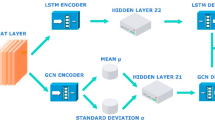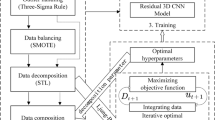Abstract
Abnormal electricity consumption detection is of great significance for maintaining the safe and stable operation of the power grids, or for reducing the irregular electricity consumption and economic losses. However, not enough attention has been paid to comprehensively explore the multi-scale characteristics of the consumption series, and to discover the intra-series relationships among different timestamps. To tackle such problems, this paper proposes an empirical mode decomposition-based multi-scale spectral graph convolution network for detecting the abnormal electricity consumptions. Firstly, the electricity consumption data are decomposed into subcomponents by the empirical mode decomposition to generate the multi-scale time characteristics, and then, the entropy feature vectors are extracted from such subcomponents and the original data. Furthermore, the feature fusion for the entropy feature vectors and the original data is realized by the multi-scale convolutional layers. Then, the spectral graph convolution network (SGCN) is employed to detect the abnormal electricity consumption and to output specific electricity consumption case. In this SGCN, both the inter-series and the intra-series relationships can be tackled by the graph Fourier transform and the graph convolution operator. Finally, detailed experiments and comparisons are done. Experimental results demonstrate that our proposed method has satisfactory accuracy and adaptability, and has much better detection performance than some popular deep and shallow methods, e.g., the CNN, LSTM, ELM and SVM.









Similar content being viewed by others
Explore related subjects
Discover the latest articles, news and stories from top researchers in related subjects.Data availability statement
The data that support the findings of this study are available from the corresponding author upon reasonable request.
References
Huang S-C, Lo Y-L, Lu C-N (2013) Non-technical loss detection using state estimation and analysis of variance. IEEE Trans Power Syst 28(3):2959–2966
Navani J, Sharma N, Sapra S (2012) Technical and non-technical losses in power system and its economic consequence in Indian economy. Int J Electron Comput Sci Eng 1(2):757–761
Li B, Xu K, Cui X, Wang Y, Ai X, Wang Y (2018) Multi-scale densenet-based electricity theft detection. In: International conference on intelligent computing, pp 172–182. Springer
McDaniel P, McLaughlin S (2009) Security and privacy challenges in the smart grid. IEEE Security Privacy 7(3):75–77
Lo C-H, Ansari N (2013) Consumer: a novel hybrid intrusion detection system for distribution networks in smart grid. IEEE Trans Emerg Top Comput 1(1):33–44
Xiao Z, Xiao Y, Du DH-C (2013) Non-repudiation in neighborhood area networks for smart grid. IEEE Commun Mag 51(1):18–26
Cárdenas AA, Amin S, Schwartz G, Dong R, Sastry S (2012) A game theory model for electricity theft detection and privacy-aware control in ami systems. In: 2012 50th Annual allerton conference on communication, control, and computing (Allerton), pp 1830–1837. IEEE
Angelos EWS, Saavedra OR, Cortés OAC, de Souza AN (2011) Detection and identification of abnormalities in customer consumptions in power distribution systems. IEEE Trans Power Delivery 26(4):2436–2442
Depuru SSSR, Wang L, Devabhaktuni V (2011) Support vector machine based data classification for detection of electricity theft. In: 2011 IEEE/PES power systems conference and exposition, pp 1–8. IEEE
Depuru SSSR, Wang L, Devabhaktuni V, Green RC (2013) High performance computing for detection of electricity theft. Int J Electrical Power Energy Syst 47:21–30
Di Martino M, Decia F, Molinelli J, Fernández A (2012) Improving electric fraud detection using class imbalance strategies. In: ICPRAM (2), pp 135–141
Jindal A, Dua A, Kaur K, Singh M, Kumar N, Mishra S (2016) Decision tree and svm-based data analytics for theft detection in smart grid. IEEE Trans Ind Inf 12(3):1005–1016
Sahoo S, Nikovski D, Muso T, Tsuru K (2015) Electricity theft detection using smart meter data. In: 2015 IEEE power and energy society innovative smart grid technologies conference (ISGT), pp 1–5. IEEE
Zheng K, Chen Q, Wang Y, Kang C, Xia Q (2018) A novel combined data-driven approach for electricity theft detection. IEEE Trans Ind Inf 15(3):1809–1819
Nagi J, Yap KS, Tiong SK, Ahmed SK, Mohamad M (2009) Nontechnical loss detection for metered customers in power utility using support vector machines. IEEE Trans Power Delivery 25(2):1162–1171
Kong X, Zhao X, Liu C, Li Q, Dong D, Li Y (2021) Electricity theft detection in low-voltage stations based on similarity measure and dt-ksvm. Int J Electrical Power Energy Syst 125:106544
Wang Y, Chen Q, Kang C, Xia Q (2016) Clustering of electricity consumption behavior dynamics toward big data applications. IEEE Trans Smart Grid 7(5):2437–2447
Lin G, Feng X, Guo W, Cui X, Liu S, Jin W, Lin Z, Ding Y (2021) Electricity theft detection based on stacked autoencoder and the undersampling and resampling based random forest algorithm. IEEE Access 9:124044–124058
Ullah A, Javaid N, Yahaya AS, Sultana T, Al-Zahrani FA, Zaman F (2021) A hybrid deep neural network for electricity theft detection using intelligent antenna-based smart meters. Wireless Commun Mobile Comput 2021
Ismail M, Shaaban MF, Naidu M, Serpedin E (2020) Deep learning detection of electricity theft cyber-attacks in renewable distributed generation. IEEE Trans Smart Grid 11(4):3428–3437
Huang Y, Xu Q (2021) Electricity theft detection based on stacked sparse denoising autoencoder. Int J Electrical Power Energy Syst 125:106448
Qiu X, Ren Y, Suganthan PN, Amaratunga GA (2017) Empirical mode decomposition based ensemble deep learning for load demand time series forecasting. Appl Soft Comput 54:246–255
Liu H, Zhang J, Cheng Y, Lu C (2016) Fault diagnosis of gearbox using empirical mode decomposition and multi-fractal detrended cross-correlation analysis. J Sound Vib 385:350–371
Chen T, Ju S, Yuan X, Elhoseny M, Ren F, Fan M, Chen Z (2018) Emotion recognition using empirical mode decomposition and approximation entropy. Comput Electrical Eng 72:383–392
Shang C, Liu Q, Tong Q, Sun J, Song M, Bi J (2021) Multi-view spectral graph convolution with consistent edge attention for molecular modeling. Neurocomputing 445:12–25
Li J, Xie X, Cao Y, Pan Q, Zhao Z, Shi G (2021) Knowledge embedded gcn for skeleton-based two-person interaction recognition. Neurocomputing 444:338–348
Wang Y, Fang S, Zhang C, Xiang S, Pan C (2022) Tvgcn: Time-variant graph convolutional network for traffic forecasting. Neurocomputing 471:118–129
Ryu S, Kwon Y, Kim WY (2019) A bayesian graph convolutional network for reliable prediction of molecular properties with uncertainty quantification. Chem Sci 10(36):8438–8446
Ren Y, Shi Y, Zhang K, Chen Z, Yan Z (2020) Medical treatment migration prediction based on gcn via medical insurance data. IEEE J Biomed Health Informatics 24(9):2516–2522
Rilling G, Flandrin P, Goncalves P, et al. (2003) On empirical mode decomposition and its algorithms. In: IEEE-EURASIP workshop on nonlinear signal and image processing, 3:8–11
Flandrin P, Rilling G, Goncalves P (2004) Empirical mode decomposition as a filter bank. IEEE Signal Process Lett 11(2):112–114
Scarselli F, Gori M, Tsoi AC, Hagenbuchner M, Monfardini G (2008) The graph neural network model. IEEE Trans Neural Netw 20(1):61–80
Wu Z, Pan S, Chen F, Long G, Zhang C, Philip SY (2020) A comprehensive survey on graph neural networks. IEEE Trans Neural Netw Learn Syst 32(1):4–24
Zhang S, Tong H, Xu J, Maciejewski R (2019) Graph convolutional networks: a comprehensive review. Comput Social Netw 6(1):1–23
Białynicki-Birula I, Mycielski J (1975) Uncertainty relations for information entropy in wave mechanics. Commun Math Phys 44(2):129–132
Pincus S (1995) Approximate entropy (apen) as a complexity measure. Chaos Interdiscip J Nonlinear Sci 5(1):110–117
Yin J, Xiao P, Li J, Liu Y, Yan C, Zhang Y (2020) Parameters analysis of sample entropy, permutation entropy and permutation ratio entropy for rr interval time series. Inf Process Manage 57(5):102283
Lee H-M, Chen C-M, Chen J-M, Jou Y-L (2001) An efficient fuzzy classifier with feature selection based on fuzzy entropy. IEEE Trans Syst Man Cybernet Part B (Cybernetics) 31(3):426–432
Pincus SM (1991) Approximate entropy as a measure of system complexity. Proc Nat Acad Sci 88(6):2297–2301
Yentes JM, Hunt N, Schmid KK, Kaipust JP, McGrath D, Stergiou N (2013) The appropriate use of approximate entropy and sample entropy with short data sets. Ann Biomed Eng 41(2):349–365
Parkash O, Sharma P, Mahajan R (2008) New measures of weighted fuzzy entropy and their applications for the study of maximum weighted fuzzy entropy principle. Inf Sci 178(11):2389–2395
Sandryhaila A, Moura JM (2013) Discrete signal processing on graphs: Graph fourier transform. In: 2013 IEEE international conference on acoustics, speech and signal processing, pp 6167–6170. IEEE
Jokar P, Arianpoo N, Leung VC (2015) Electricity theft detection in ami using customers‘ consumption patterns. IEEE Trans Smart Grid 7(1):216–226
Zanetti M, Jamhour E, Pellenz M, Penna M, Zambenedetti V, Chueiri I (2017) A tunable fraud detection system for advanced metering infrastructure using short-lived patterns. IEEE Trans Smart grid 10(1):830–840
Makonin S (2018) Hue: The hourly usage of energy dataset for buildings in British Columbia. Technical report
Wei P, He F, Li L, Li J (2020) Research on sound classification based on svm. Neural Comput Appl 32(6):1593–1607
Koda S, Zeggada A, Melgani F, Nishii R (2018) Spatial and structured svm for multilabel image classification. IEEE Trans Geosci Remote Sens 56(10):5948–5960
Liu L, Martín-Barragán B, Prieto FJ (2021) A projection multi-objective svm method for multi-class classification. Comput Ind Eng 158:107425
Huang G-B, Zhu Q-Y, Siew C-K (2006) Extreme learning machine: theory and applications. Neurocomputing 70(1–3):489–501
Wan Y, Song S, Huang G, Li S (2017) Twin extreme learning machines for pattern classification. Neurocomputing 260:235–244
Yahia S, Said S, Zaied M (2022) Wavelet extreme learning machine and deep learning for data classification. Neurocomputing 470:280–289
Wang Q, Dou Y, Liu X, Lv Q, Li S (2016) Multi-view clustering with extreme learning machine. Neurocomputing 214:483–494
Hochreiter S, Schmidhuber J (1997) Long short-term memory. Neural Comput 9(8):1735–1780
Nguyen H, Tran KP, Thomassey S, Hamad M (2021) Forecasting and anomaly detection approaches using lstm and lstm autoencoder techniques with the applications in supply chain management. Int J Inf Manage 57:102282
Zhang Q, Wang X, Wu YN, Zhou H, Zhu S-C (2020) Interpretable cnns for object classification. IEEE Trans Pattern Anal Mach Intell 43(10):3416–3431
Singhal S, Passricha V, Sharma P, Aggarwal RK (2019) Multi-level region-of-interest cnns for end to end speech recognition. J Ambient Intell Human Comput 10(11):4615–4624
Quan Y, Chen Y, Shao Y, Teng H, Xu Y, Ji H (2021) Image denoising using complex-valued deep cnn. Pattern Recogn 111:107639
Acknowledgements
This study is partly supported by the National Natural Science Foundation of China (Nos. 62076150, 62133008, 61903226), the Taishan Scholar Project of Shandong Province (No. TSQN201812092), the Key Research and Development Program of Shandong Province (No. 2021CXGC011205, 2021TSGC1053), and the Youth Innovation Technology Project of Higher School in Shandong Province (No. 2019KJN005).
Author information
Authors and Affiliations
Corresponding author
Ethics declarations
Conflict of interest
The authors declare that they have no conflict of interest.
Additional information
Publisher's Note
Springer Nature remains neutral with regard to jurisdictional claims in published maps and institutional affiliations.
Rights and permissions
Springer Nature or its licensor (e.g. a society or other partner) holds exclusive rights to this article under a publishing agreement with the author(s) or other rightsholder(s); author self-archiving of the accepted manuscript version of this article is solely governed by the terms of such publishing agreement and applicable law.
About this article
Cite this article
Meng, S., Li, C., Peng, W. et al. Empirical mode decomposition-based multi-scale spectral graph convolution network for abnormal electricity consumption detection. Neural Comput & Applic 35, 9865–9881 (2023). https://doi.org/10.1007/s00521-023-08222-8
Received:
Accepted:
Published:
Issue Date:
DOI: https://doi.org/10.1007/s00521-023-08222-8




